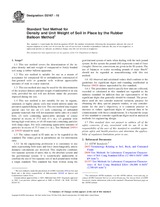Potrebujeme váš súhlas na využitie jednotlivých dát, aby sa vám okrem iného mohli ukazovať informácie týkajúce sa vašich záujmov. Súhlas udelíte kliknutím na tlačidlo „OK“.
ASTM D2167-15
Standard Test Method for Density and Unit Weight of Soil in Place by the Rubber Balloon Method (Withdrawn 2024)
Automaticky preložený názov:
Štandardná skúšobná metóda pre hustoty a jednotka ťarcha zeminy na mieste gumového Balloon metódy
NORMA vydaná dňa 1.7.2015
Informácie o norme:
Označenie normy: ASTM D2167-15
Poznámka: NEPLATNÁ
Dátum vydania normy: 1.7.2015
Kód tovaru: NS-611336
Počet strán: 6
Približná hmotnosť: 18 g (0.04 libier)
Krajina: Americká technická norma
Kategória: Technické normy ASTM
Kategórie - podobné normy:
Zemní práce. Hloubicí práce. Budování základů. Podzemní práce
Anotácia textu normy ASTM D2167-15 :
Keywords:
acceptance tests, balloon test, compaction tests, degree of compaction, densitometer test, density tests, field control tests, inplace density, inplace dry density, in situ density, relative density, soil tests, unit weight,, ICS Number Code 93.020 (Earth works. Excavations. Foundation construction. Underground works)
Doplňujúce informácie
| Significance and Use | ||||||||||||||||||||||||||||
|
5.1 This test method can be used to determine the in-place density and unit weight of natural inorganic soil deposits, soil-aggregate mixtures, or other similar firm materials. It is often used as a basis of acceptance for earthen material compacted to a specified density or percentage of a maximum density determined by a test method, such as Test Methods D698, D1557 or D4253. 5.1.1 Test Methods D698 and D1557 require that mass measurements of laboratory compacted test specimens be determined to the nearest 1 g so that computed water contents and densities can be reported to three and four significant digits, respectively. This standard is a field procedure requiring mass measurements to the nearest 5 g. As such, water content calculations should only be reported to two significant digits and density to three significant digits. 5.2 This test method may be used to determine the density and unit weight of compacted soils used in construction of earth embankments, road fill, and structural backfill. This test method often is used as a basis of acceptance for soils compacted to a specified density or a percentage of maximum density or unit weight, as determined by a standard test method. 5.3 The use of this test method is generally limited to soil in an unsaturated condition and is not recommended for soils that are soft or that deform easily. Such soils may undergo a volume change during the application of pressure during testing. This test method may not be suitable for soils containing crushed rock fragments or sharp edge materials, which may puncture the rubber membrane. Note 1: The quality of the result produced by this standard is
dependent on the competence of the personnel performing it and the
suitability of the equipment and the facilities used. Agencies that
meet the criteria of Practice D3740 are generally considered capable of
competent and objective testing. Users of this standard are
cautioned that compliance with Practice D3740 does not in itself ensure reliable
results. Reliable results depend on many factors; Practice
D3740 provides a means of
evaluating some of those factors.
|
||||||||||||||||||||||||||||
| 1. Scope | ||||||||||||||||||||||||||||
|
1.1 This test method covers the determination of the in-place density and unit weight of compacted or firmly bonded soil using a rubber balloon apparatus. 1.2 This test method is suitable for use as a means of acceptance for compacted fill or embankments constructed of fine-grained soils or granular soils without appreciable amounts of rock or coarse material. 1.3 This test method also may be used for the determination of the in-place density and unit weight of undisturbed or in situ soils, provided the soil will not deform under the pressures imposed during the test. 1.4 This test method is not suitable for use in organic, saturated, or highly plastic soils that would deform under the pressures applied during this test. This test method may require special care for use on (1) soils consisting of unbonded granular materials that will not maintain stable sides in a small hole, (1.5 The values stated in SI units are to be regarded as the standard. The values given in parentheses are for information only. 1.5.1 In the engineering profession it is customary to use units representing both mass and force interchangeably, unless dynamic calculations are involved. This implicitly combines two separate systems of units; that is, the absolute system and the gravitational system. It is scientifically undesirable to combine the use of two separate sets of inch-pound units within a single standard. This standard has been written using the gravitational system of units when dealing with the inch-pound system. In this system the pound (lbf) represents a unit of force (weight). However, conversions are given in the SI system. The use of balances or scales recording pounds of mass lbm/ft3 should not be regarded as nonconforming with this test method. 1.6 All observed and calculated values shall conform to the guidelines for significant digits and rounding established in Practice D6026 unless superseded by this standard. 1.6.1 The procedures used to specify how data are collected, recorded or calculated in this standard are regarded as the industry standard. In addition they are representative of the significant digits that generally should be retained. The procedures used do not consider material variation, purpose for obtaining the data, special purpose studies, or any considerations for the user’s objectives; it is common practice to increase or reduce significant digits of reported data to be commensurate with these considerations. It is beyond the scope of this standard to consider significant digits used in analytical methods for engineering design. 1.7 This standard does not purport to address all of the safety concerns, if any, associated with its use. It is the responsibility of the user of this standard to establish appropriate safety and health practices and determine the applicability of regulatory limitations prior to use. |
||||||||||||||||||||||||||||
| 2. Referenced Documents | ||||||||||||||||||||||||||||
|




 Cookies
Cookies
